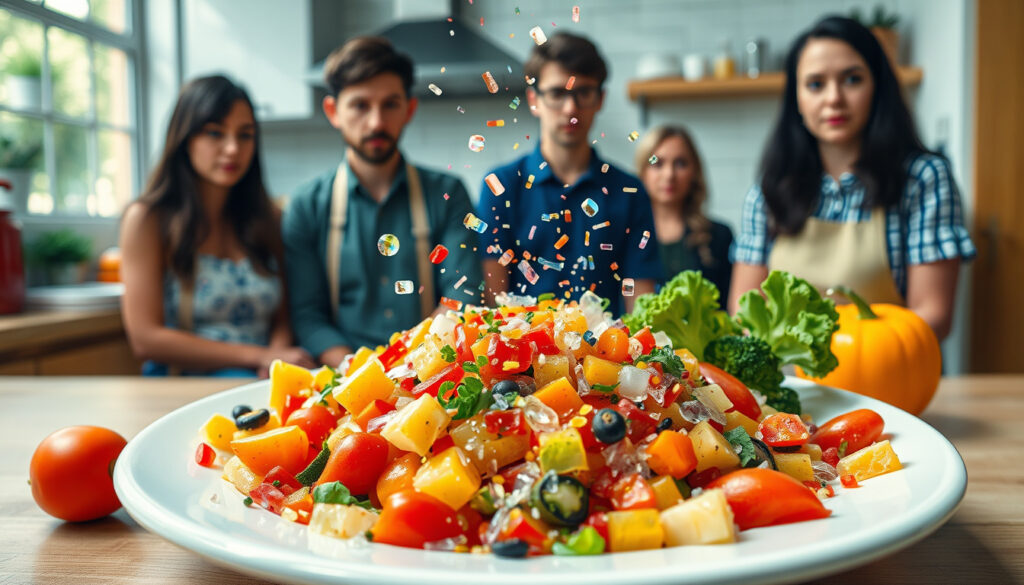The Plastic Platter: Navigating the Microplastic Minefield in Your Food
Guess what? It turns out that when it comes to microplastics, we’re talking about not just the great outdoors but our kitchens too! That’s right, folks—those pesky microplastics are invading our plates, and they’ve brought their friends! Researchers estimate that we could be consuming anywhere between 39,000 to 52,000 microplastic particles each year! But wait, there’s more! With breathing included, that number rises dramatically to a whopping 74,000 to 121,000. It seems like microplastics are throwing quite the party in our bodies!
Recently, researchers found an actual plastic spoon’s worth of these tiny plastic shards in human brain tissue. Talk about a bold statement! If you thought your plastic fork had water cooler gossip, just wait until you hear what’s going on inside your head—yikes!
The Plastic Conundrum: What Are Microplastics?
Microplastics are tiny pieces of plastic that come from various sources, and they are as ubiquitous as puns in a dad’s conversation. From our water to our clothes, and even in the kitchen, they’ve made themselves very comfortable. But how did this dilemma all start?
Dr. Joseph Mercola, a board-certified family medicine osteopathic physician, explains that microplastics can easily infiltrate our food supply through contaminated soil and water. They can hitch a ride on plastic mulch in agriculture and even come from our plastic-packed snacks. Talk about a plastic predicament!
While the US Food and Drug Administration assures us that there’s no solid evidence suggesting that microplastics in food pose a health risk, one thing is certain: Keeping our exposure as low as possible seems like a reasonable plan, unless you’re looking for a new flavor of plastic lemonade.
Top Microplastic Offenders: What’s on Your Plate?
So, just what are we eating that’s playing host to these unruly microplastics? Buckle up, because here are the top ten food suspects!
1. Seafood: The Ocean’s Plastic Buffet
Fish and shellfish are major players in the microplastic game. A study from the Portland State University found tiny plastic bits in 180 out of 182 seafood samples tested. Turns out that when plastics break down in the ocean, plankton mistake them for food, leading to fish getting a ‘bit’ of a different meal!
2. Tea Bags: A Brewing Concern
Who knew your cup of tea could also serve up a side of microplastics? Polypropylene tea bags may release billions of particles into your brew! So, if your tea is feeling a little tacky, it may just be those sneaky plastic fibers!
How to Avoid It: Switch to loose-leaf tea and a stainless steel diffuser—now that’s brewing a good time!
3. Rice: A Sticky Situation
With a shocking study indicating 3-4 milligrams of plastic in every half-cup of rice, the grains are becoming less of a staple and more of a plastic platter!
How to Avoid It: Wash that rice! It may reduce contamination by 20-40%. Just don’t start washing it with dish soap—that might create its own kind of ‘rice-a-roni’!
4. Salt and Sugar: The Grains of Salt
When you sprinkle salt on your dinner, you might be adding… microplastics? Yup! About 90% of salt brands globally contain microplastics. Talk about a salty surprise!
How to Avoid It: Opt for salt and sugar packed in glass or cardboard, and make your dishes sweet and salty sans the plastic.
5. Bottled Water: Sipping on Plastics
Who thought that drinking from a plastic bottle could come with a side order of 240,000 plastic particulates per liter? The PET plastic from bottles sure knows how to stick around.
How to Avoid It: Ditch those bottles and opt for tap water in stainless steel or glass containers. Cheers to clear sipping!
6. Honey: Nature’s Sweet Sidekick
Even honey has microplastics lurking in there! It turns out that the busy bees might be transporting these pesky particles back to their hives.
How to Avoid It: Support local beekeepers who use sustainable practices. Sweetness without the baggage!
7. Fruits and Vegetables: Garden Harvest Gone Wrong
Apples and carrots have been found to harbor microplastics. Plants can uptake these pesky particles right from the soil. How’s that for eating local?
How to Avoid It: Wash your produce thoroughly and consider peeling when possible. A little more labor for your salad never hurt anyone!
8. Proteins: A Meaty Matter
A study from the Ocean Conservancy found that 88% of vegetable and animal proteins contain microplastics. Highly processed options are especially guilty, adding even more mystery to your meal.
How to Avoid It: More research is needed! Just remember, a balanced protein source is key, even if you’re skipping the microplastics.
9 & 10. Plastic Utensils and Storage: A Double Whammy
Many plastic utensils and containers can transfer those nasty chemicals into your food. It’s like a double whammy of plastic!
How to Avoid It: Swap those plastic utensils and containers for stainless steel, glass, or wood. Your meals will appreciate it, and so will your gut!
Is There a Safe Level of Microplastics?
As of now, there’s no established safe level of microplastic consumption, and while the long-term effects remain under scrutiny, it’s better to keep your eye on the prize—minimized exposure, that is. So, keep dodging those microplastics where you can!
Wrap-Up: Don’t Worry, Be Happy—Eat Wisely!
While the fight against microplastics feels a bit overwhelming, fear not! Following expert tips like steering clear of plastic-wrapped foods and using filters can lead you on a path to a healthier lifestyle. It’s all about enjoying what’s on your plate—after all, life’s too short to take it too seriously!
So next time you’re at the dinner table, just remember, the best ingredient is always a sprinkle of laughter (minus the microplastics, please)! Happy eating!
Follow us at Pasta From the Sea for more nutrition news!
